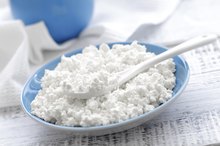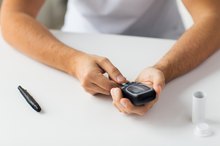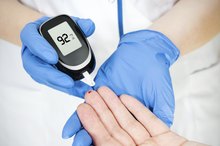Diabetic Symptoms After Eating
Diabetes, or diabetes mellitus, is a condition that affects how your body reacts to and utilizes glucose, or blood sugar--the body's main energy source derived from food. Numerous diabetes symptoms occur after eating, when glucose levels are directly affected in response to food. According to the National Diabetes Association, 5.7 million Americans have diabetes and don't realize they have it. If you experience symptoms of diabetes, seek guidance from your doctor.
Hunger After Eating
After a person eats, glucose from the food enters the blood stream and moves through the body and into its cells. Insulin, a hormone made by the pancreas, then converts the glucose into energy. Since people with diabetes do not have usual responses to glucose, they may suffer a drop in blood sugar, known as hypoglycemia. Hunger after eating is a common hypoglycemic symptom that affects people with diabetes. According to the National Diabetes Information Clearinghouse, hypoglycemia can come on suddenly and commonly occur after a person with diabetes makes inappropriate food choices, fails to take appropriate medication or overeats at a meal. Drinking excessive amounts of alcohol can also trigger a hypoglycemic response, such as hunger.
- After a person eats, glucose from the food enters the blood stream and moves through the body and into its cells.
- According to the National Diabetes Information Clearinghouse, hypoglycemia can come on suddenly and commonly occur after a person with diabetes makes inappropriate food choices, fails to take appropriate medication or overeats at a meal.
Added Thirst and Urination
What Are the Blood Sugar Levels for Diabetes?
Learn More
People with diabetes may also experience high blood sugar, or hyperglycemia, after meals due to excess glucose build up in the blood. When this happens, your kidneys attempt to filter and absorb the excess sugar. When glucose levels are extremely high, the kidneys may be unable to keep up. Thus, excess sugar is excreted through urine, leading to frequent urination. As this happens, your thirst increases, causing further increased urination. According to the National Institutes of Health, excess thirst and frequent urination are some of the most common diabetes symptoms and are often the first symptoms people experience prior to diagnosis. In severe cases, excess or frequent urination is a symptom of ketoacidosis, a potentially life-threatening complication of diabetes. For this reason, if your thirst and urination symptoms are severe, or if you experience additional symptoms such as excessively dry mouth, difficulty breathing, nausea, or vomiting, seek emergency medical attention.
- People with diabetes may also experience high blood sugar, or hyperglycemia, after meals due to excess glucose build up in the blood.
- In severe cases, excess or frequent urination is a symptom of ketoacidosis, a potentially life-threatening complication of diabetes.
Tiredness
While food is intended to provide food and energy, people with diabetes may feel tired, rather than energized after a meal, due to drops in blood sugar. This symptom most frequently occurs after a large or sugar-rich meal or dessert. Many people without diabetes experience mild, temporary tiredness after eating. For people with diabetes, however, tiredness after eating is a frequent, potentially-severe symptom. People diagnosed with diabetes usually learn to recognize such symptoms promptly and depend upon glucose tablets, fruit juice or foods containing glucose to increase their blood sugar to healthy levels before symptoms worsen. The NDIC suggests that those who experience diabetic symptoms, such as tiredness after meals several times per week, seek medical guidance.
- While food is intended to provide food and energy, people with diabetes may feel tired, rather than energized after a meal, due to drops in blood sugar.
Related Articles
References
Writer Bio
August McLaughlin is a certified nutritionist and health writer with more than nine years of professional experience. Her work has been featured in various magazines such as "Healthy Aging," "CitySmart," "IAmThatGirl" and "ULM." She holds specializations in eating disorders, healthy weight management and sports nutrition. She is currently completing her second cookbook and Weight Limit—a series of body image/nutrition-related PSAs.









